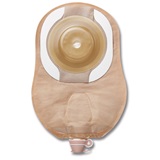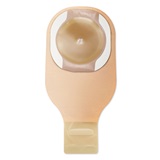What You Need to Know About Ostomy Pouching Systems
Choosing the right pouching system is an important decision after your ostomy surgery. Find what you need to know here.

Learn the facts about ostomy pouching systems.
The ostomy pouching system you received in the hospital may be designed to work for a variety of different stomas. After you get home, it’s a good idea to try different pouching systems to see what works best for your stoma. Here’s some fundamental information about pouching systems to help you find the one that’s right for you.
One-piece and two-piece ostomy pouching systems
There are two types of pouching systems: one-piece and two-piece. Each has different advantages.
Both pouching system types include a skin barrier and pouch. The skin barrier is the adhesive portion of your pouching system that is immediately around your stoma. It protects your skin and holds your pouching system in place, so it’s important to choose the right skin barrier. It’s sometimes called a wafer. The pouch is the bag that collects output from the stoma.
One-piece pouching system: With this type of system, the skin barrier is permanently attached to the pouch, so it’s a single unit. When changing a one-piece pouching system, the pouch and skin barrier are removed together. The system is simple to apply – just peel and stick. Another advantage is that it lies flatter against the skin and may show less under clothing. If you happen to have a bulge or hernia near your stoma, you may get the best fit with a one-piece pouch.
Two-piece pouching system: This system is the most versatile. It includes a skin barrier and pouch as two separate pieces. The plastic ring, or flange, in a two-piece system connects the two parts together, making it easy to unsnap and discard the pouch. The two-piece pouching system allows you to change your pouch while the skin barrier stays in place on your body. You can wear different pouches depending on your activity level – for example, changing to a smaller pouch for sports or intimacy.
Here’s a quick rundown of some of the factors to consider when choosing a pouching system.
|
A one-piece system might be right for you if… |
A two-piece system might be right for you if… |
|
You prefer a simpler peel-and-stick system with fewer steps |
You prefer the skin barrier to stay in place when changing your pouch |
|
You’re concerned about your ostomy pouch showing through clothing |
You want to change your pouch more frequently than the skin barrier |
|
You have a bulge or hernia near your stoma |
You plan on wearing different pouches for exercise or intimacy |
|
You have arthritis, poor eyesight, or other challenges that make a simpler system easier to use |
You’re concerned that frequent skin barrier changes will cause irritation around your stoma |
|
You’re concerned about costs (one-piece systems are generally more affordable) |
You want to change fast on the go (a used pouch can be removed and a new one attached quickly |
Drainable and closed ostomy pouches
There are two types of ostomy pouches: drainable pouches and closed pouches, each with their own advantages.
Drainable pouches: These have either a clamp or an integrated closure (a closure mechanism that is built into the pouch). They are meant to be emptied when they are about one-third to half full of output. You should consider using a drainable pouch if you have output frequently throughout the day. Emptying the pouch is quick and easy. If you’ve had a urostomy, you’ll be using a drainable pouch with a valve. (Urostomy pouches are somewhat different – explore urostomy pouch basics.)
Closed pouches: You can simply remove and dispose of these pouches — there is no draining needed. You could consider using a closed pouch if your output is less frequent, and your pouch needs to be emptied just one or two times a day. Closed pouches do not have clamps and must be replaced to be emptied. You remove and empty it, then throw it away.
Pouches are available in several lengths, and in ultra-clear, transparent, and opaque. You can also select pouches that have a soft cover, to help increase your comfort and provide added discretion.
To help you choose the right pouch, here’s a quick decision guide.
|
Choosing a pouch |
|
|
Situation |
Consider… |
|
Your discharge is formed, and you have gas |
Filtered pouches |
|
You want to see your stoma and pouch content |
Clear pouches |
|
You prefer not to see your stoma and pouch content |
Beige pouches |
|
Your output is infrequent (one or two times a day) |
Closed pouches |
|
Your output is frequent (three times or more per day) |
Drainable pouches |
Work with your stoma care nurse
The decisions you make regarding your pouching system will impact you daily, so it’s vital that you make the best product choices based on your unique needs. Your stoma care nurse is a valuable resource when making these decisions.- 0 Shares
- 96 Recommended





 Call Us
Call Us  Email Us
Email Us  Join Us!
Join Us!  Sign Up
Sign Up 